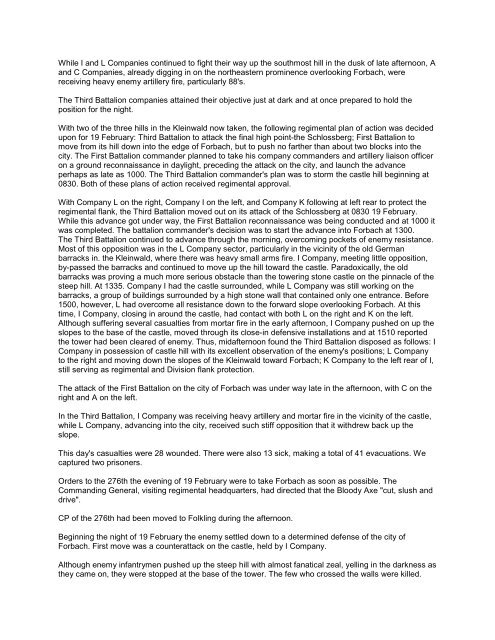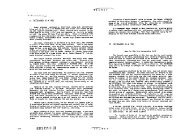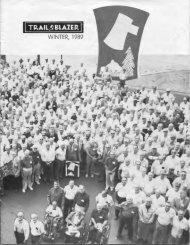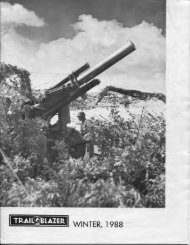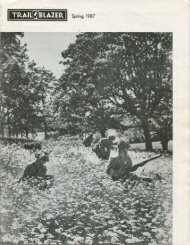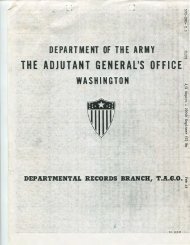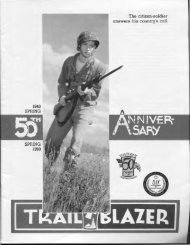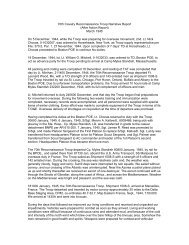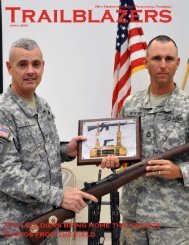Download - 70th Infantry Division Association
Download - 70th Infantry Division Association
Download - 70th Infantry Division Association
You also want an ePaper? Increase the reach of your titles
YUMPU automatically turns print PDFs into web optimized ePapers that Google loves.
While I and L Companies continued to fight their way up the southmost hill in the dusk of late afternoon, A<br />
and C Companies, already digging in on the northeastern prominence overlooking Forbach, were<br />
receiving heavy enemy artillery fire, particularly 88's.<br />
The Third Battalion companies attained their objective just at dark and at once prepared to hold the<br />
position for the night.<br />
With two of the three hills in the Kleinwald now taken, the following regimental plan of action was decided<br />
upon for 19 February: Third Battalion to attack the final high point-the Schlossberg; First Battalion to<br />
move from its hill down into the edge of Forbach, but to push no farther than about two blocks into the<br />
city. The First Battalion commander planned to take his company commanders and artillery liaison officer<br />
on a ground reconnaissance in daylight, preceding the attack on the city, and launch the advance<br />
perhaps as late as 1000. The Third Battalion commander's plan was to storm the castle hill beginning at<br />
0830. Both of these plans of action received regimental approval.<br />
With Company L on the right, Company I on the left, and Company K following at left rear to protect the<br />
regimental flank, the Third Battalion moved out on its attack of the Schlossberg at 0830 19 February.<br />
While this advance got under way, the First Battalion reconnaissance was being conducted and at 1000 it<br />
was completed. The battalion commander's decision was to start the advance into Forbach at 1300.<br />
The Third Battalion continued to advance through the morning, overcoming pockets of enemy resistance.<br />
Most of this opposition was in the L Company sector, particularly in the vicinity of the old German<br />
barracks in. the Kleinwald, where there was heavy small arms fire. I Company, meeting little opposition,<br />
by-passed the barracks and continued to move up the hill toward the castle. Paradoxically, the old<br />
barracks was proving a much more serious obstacle than the towering stone castle on the pinnacle of the<br />
steep hill. At 1335. Company I had the castle surrounded, while L Company was still working on the<br />
barracks, a group of buildings surrounded by a high stone wall that contained only one entrance. Before<br />
1500, however, L had overcome all resistance down to the forward slope overlooking Forbach. At this<br />
time, I Company, closing in around the castle, had contact with both L on the right and K on the left.<br />
Although suffering several casualties from mortar fire in the early afternoon, I Company pushed on up the<br />
slopes to the base of the castle, moved through its close-in defensive installations and at 1510 reported<br />
the tower had been cleared of enemy. Thus, midafternoon found the Third Battalion disposed as follows: I<br />
Company in possession of castle hill with its excellent observation of the enemy's positions; L Company<br />
to the right and moving down the slopes of the Kleinwald toward Forbach; K Company to the left rear of I,<br />
still serving as regimental and <strong>Division</strong> flank protection.<br />
The attack of the First Battalion on the city of Forbach was under way late in the afternoon, with C on the<br />
right and A on the left.<br />
In the Third Battalion, I Company was receiving heavy artillery and mortar fire in the vicinity of the castle,<br />
while L Company, advancing into the city, received such stiff opposition that it withdrew back up the<br />
slope.<br />
This day's casualties were 28 wounded. There were also 13 sick, making a total of 41 evacuations. We<br />
captured two prisoners.<br />
Orders to the 276th the evening of 19 February were to take Forbach as soon as possible. The<br />
Commanding General, visiting regimental headquarters, had directed that the Bloody Axe "cut, slush and<br />
drive".<br />
CP of the 276th had been moved to Folkling during the afternoon.<br />
Beginning the night of 19 February the enemy settled down to a determined defense of the city of<br />
Forbach. First move was a counterattack on the castle, held by I Company.<br />
Although enemy infantrymen pushed up the steep hill with almost fanatical zeal, yelling in the darkness as<br />
they came on, they were stopped at the base of the tower. The few who crossed the walls were killed.


